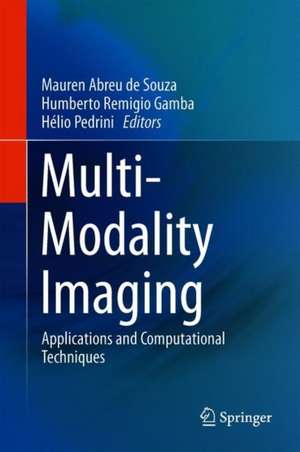Multi-Modality Imaging: Applications and Computational Techniques
Editat de Mauren Abreu de Souza, Humberto Remigio Gamba, Helio Pedrinien Limba Engleză Hardback – 12 dec 2018
In particular, this book covers imaging combinations coming from the usual popular modalities (such as the anatomical modalities, e.g. X-ray, CT and MRI), and it also includes some promising and new imaging modalities that are still being developed and improved (such as infrared thermography (IRT) and photoplethysmography imaging (PPGI)), implying potential approaches for innovative biomedical applications.
Moreover, this book includes a variety of tools on computer vision, imaging processing, and computer graphics, which led to the generation and visualization of 3D models, making the most recent advances in this area possible. This is an ideal book for students and biomedical engineering researchers covering the biomedical imaging field.
Preț: 949.42 lei
Preț vechi: 1157.82 lei
-18% Nou
Puncte Express: 1424
Preț estimativ în valută:
181.69€ • 197.29$ • 152.62£
181.69€ • 197.29$ • 152.62£
Carte tipărită la comandă
Livrare economică 22 aprilie-06 mai
Preluare comenzi: 021 569.72.76
Specificații
ISBN-13: 9783319989730
ISBN-10: 3319989731
Pagini: 272
Ilustrații: XIV, 256 p. 110 illus., 93 illus. in color.
Dimensiuni: 155 x 235 mm
Greutate: 0.56 kg
Ediția:1st ed. 2018
Editura: Springer International Publishing
Colecția Springer
Locul publicării:Cham, Switzerland
ISBN-10: 3319989731
Pagini: 272
Ilustrații: XIV, 256 p. 110 illus., 93 illus. in color.
Dimensiuni: 155 x 235 mm
Greutate: 0.56 kg
Ediția:1st ed. 2018
Editura: Springer International Publishing
Colecția Springer
Locul publicării:Cham, Switzerland
Cuprins
Infrared Thermography.- Photoplethysmography Imaging and Common Optical Hybrid Imaging Modalities.- Multimodal Image Fusion for Cardiac Resynchronization Therapy Planning.- CFD based post-processing of CT-MRI data to determine the Mechanics of Rupture in Abdominal Aortic Aneurysms.- Human Head Modelling Simulation Applied to Electroconvulsive Therapy.- Magnetic Resonance Imaging for Brain Mapping.- The use of photon scattering interactions in the diagnosis and treatment of disease.- Digital Breast Tomosynthesis: systems, characterization and simulation.- Out-of-Core Rendering of Large Volumetric Data Sets at Multiple Levels of Detail.- Geometric and Topological Modelling of Organs and Vascular Structures from CT Data.- Index.
Notă biografică
Mauren Abreu de Souza is affiliated with the Pontifical Catholic University of Paraná (PUCPR), in Curitiba, Brazil. She received her Ph.D. degree in Medical Physics and Bioengineering from University College London (2009), UK. She received her M.Sc. in Electrical Engineering (emphasis: Biomedical Engineering) from the Federal University of Technology – Paraná (UTFPR), (2002), Brazil. She has a degree in Physics (B.Sc together with physics’ teaching) from the Federal University of Paraná – UFPR (1999), in Curitiba, Brazil. Her research interests include 3D multimodality imaging, 3D image reconstruction, computed tomography (CT) images, rapid prototyping, optical tomography, infrared thermal images, and 3D modelling (e.g. photogrammetry and 3D scanning systems).
Humberto Remigio Gamba is currently a professor in the Federal University of Technology – Paraná (UTFPR), Curitiba, Brazil. He received his Ph.D. degree in Medical Physics from University College London (1996), UK. He received his M.Sc. in Electrical Engineering from the University of Campinas (1989), Brazil. His B.Sc. degree in Electrical Engineering from the Federal University of Technology – Paraná (UTFPR), (1986), in Curitiba, Brazil. His research interests include Biomedical engineering (emphasis in both medical and dentistry instrumentation), image processing, ultrasound, and functional magnetic resonance (fMRI).
Helio Pedrini is currently a professor in the Institute of Computing at the University of Campinas, Brazil. He received his Ph.D. degree in Electrical and Computer Engineering from Rensselaer Polytechnic Institute, Troy, NY, USA. He received his M.Sc. in Electrical Engineering and his B.Sc. in Computer Science, both degrees from the University of Campinas, Brazil. His research interests include image processing, computer vision, pattern recognition, machine learning, computer graphics, and scientific visualization.
Textul de pe ultima copertă
This book presents different approaches on multi-modality imaging with a focus on biomedical applications. Medical imaging can be divided into two categories: functional (related to physiological body measurements) and anatomical (structural) imaging modalities.
In particular, this book covers imaging combinations coming from the usual popular modalities (such as the anatomical modalities, e.g. X-ray, CT and MRI), and it also includes some promising and new imaging modalities that are still being developed and improved (such as infrared thermography (IRT) and photoplethysmography imaging (PPGI)), implying potential approaches for innovative biomedical applications.
Moreover, this book includes a variety of tools on computer vision, imaging processing, and computer graphics, which led to the generation and visualization of 3D models, making the most recent advances in this area possible. This is an ideal book for students and biomedical engineering researchers covering the biomedical imaging field.
In particular, this book covers imaging combinations coming from the usual popular modalities (such as the anatomical modalities, e.g. X-ray, CT and MRI), and it also includes some promising and new imaging modalities that are still being developed and improved (such as infrared thermography (IRT) and photoplethysmography imaging (PPGI)), implying potential approaches for innovative biomedical applications.
Moreover, this book includes a variety of tools on computer vision, imaging processing, and computer graphics, which led to the generation and visualization of 3D models, making the most recent advances in this area possible. This is an ideal book for students and biomedical engineering researchers covering the biomedical imaging field.
Caracteristici
Presents different approaches on multi-modality imaging including functional (related to physiological body measurements) and anatomical (structural) imaging modalities Broadens readers’ understanding of medical applications for both invasive (e.g. CT, X-ray diffraction and Tomosynthesis) and non-invasive imaging modalities (e.g. infrared thermography (IRT), photoplethysmography imaging (PPGI), and MRI) Covers in detail 3D image modelling for a variety of applications, including some computational approaches, such as out-of-core volume rendering of massive high resolution data and visualization of 3D models for surgery planning and training applications
